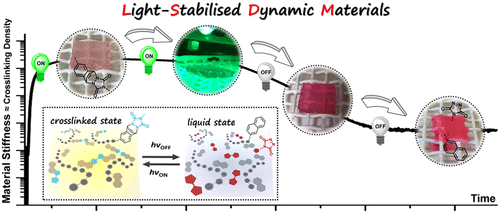Researchers from different universities have collaborated to develop a new type of photosensitive dynamic material that alters its polymer structure due to changes in light conditions. As a result, it can dissolve in darkness, the opposite of how light-based polymerisation works in DLP 3D printers.
“Typically, you use different wavelengths of light or additional heat or harsh chemicals to break up the polymer molecule chains that form a network structure,” said Professor Barner-Kowollik and Dr Hannes Houck (Queensland University of Technology). “However, in this case, we used green LED light to stabilise the network. The trigger to break up the network, make it collapse and flow away is actually the mildest one of all: darkness. Switch the light back on and the material re-hardens and retains its strength and stability.”
The dynamic material comprises the coupling molecules triazolinediones (TADs) and naphthalenes. The materials are also quite inexpensive (naphthalenes are a common ingredient in ingredient in moth repellents). The researchers believe their work should become a whole new class of materials called Light-Stabilized Dynamic Materials (LSDMs).
“We debated whether to patent the new material, but decided not to wait and to publish the findings to advance knowledge and understanding of the processes involved,” Dr Houck said.
Photosensitive Supports
The concept of 3D printing supports from these inks has a lot of potential. The light-stabilised dynamic materials could form scaffolds that are 3D printable under light, then the scaffold ink could flow away when the light is switches off. Photosensitive Support structures like these could be easily printable with a secondary material and just as easily removed. On top of that, this current formulation is quite cheap, so cost may not be an issue either.
Even aside from photosensitive supports, the material could have benefits for 4D printing applications. They could also form interesting light-sensitive robotics and physical programs. Perhaps medical science and biotech could also use a material that can switch hardness on command. There are many possible applications for this class of inks and the research is merely scratching the surface.
The researchers are already looking to find new materials with chemical combinations that can achieve the same result. Professor Barner-Kowollik states that the researchers have already been contacted by 3D printing technology companies interested in applying the research. It already looks like this material will have a bright future ahead.
Featured image courtesy of the researchers, retrieved via the original study.


